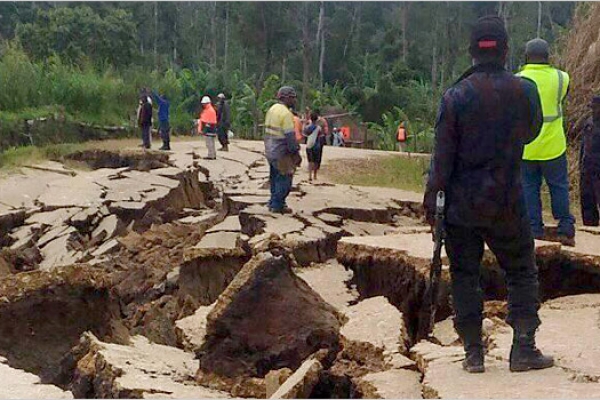Papua New Guinea was hit by a massive 7.6 earthquake this Sunday morning. The earthquake caused the buildings to collapse, landslides and cracked road paths. The tremors were felt at 6:46 am local time. There has been no official update from the government on the situation that states the aftermath of the earthquake but photos from the general public have emerged that showcase debris was strewn all over the streets and cracked-up roads.
According to the geological survey of the United States, the earthquake was felt in a town of 8,500 people called Kainantu at a depth of 90 Kilometers. The small town is located in the northeastern region of the country. Currently, there have been no official reports on the death count.
There is no threat of tsunami waves hitting the shores of Indonesia and Papua New Guinea, according to the National Tsunami Warning Center. But earlier it was predicted that within a thousand kilometers, big terrible tsunami waves could be possible.

The Ring of Fire
Papua New Guinea falls under the affected regions in the “ring of fire.” The infamous ring of fire is a dangerous earthquake-prone area where frequent massive earthquakes shake up the land and the seas periodically. Many times, the earthquake impacts carry over to other neighboring countries or when tremendously huge earthquakes of 8+ Richter scale occur, the damage from the tsunami could be carried over to even extremely far away regions like the Middle east or Australia.

The ring of fire stretches along a 40,000 kilometers arc. The distance is covered from the pacific plate boundary to the much smaller Philippines Sea plate. The ring is also home to most of the world’s active volcanoes.
Just this Saturday, Indonesia was struck by consecutive strong tremors and quakes which had shaken up the eastern region of the country. A total of four land earthquakes between the magnitudes of 6.2 and 5.5 were recorded in west Papua province. The earthquakes occurred at a depth of 16 km.
The residents of the ring of fire regions are often well-versed in how to deal with earthquakes no matter the magnitude. The houses are usually short and made on a strong foundation to decrease debris from buildings falling. That’s why low death counts are recorded in events like this but in 2018 Papua New Guinea lost 60 people(with 500+ injured) due to an earthquake of a similar magnitude as the Sunday morning.
Papua New Guinea’s tryst with Climate Crisis
The Oceania islands are also used to natural calamities like this and the government will be taking safety precautions to deal with the aftermath of the earthquake. Earlier this year, Tonga’s volcano eruption also caused quite a stir among the general population both near the small island country as well as in international nations.
Though, several environmentalists also have predicted that Oceania is one of the most vulnerable regions in the world which will face dire consequences due to climate change. Oceanic life is already facing severe problems such as huge coral reefs dying and endangered aquatic species numbers decreasing. There have been attempts at recovery which are showing little to no chances of improvement. It will be an uphill task to try and battle through to recover from the loss.

The Australian wildfires have destroyed a significant amount of trees in the country, whereas the sea water levels also keep rising. The ordinary people on the shores who might have no knowledge about the climate crisis and things are also moving very fast. Almost 87% of Papua New Guinea’s population live in poverty and they will also be the most affected group of people when climate change risks increase all through the world.
Papua new guinea is ranked tenth as the most vulnerable country to the risk of climate change. The nation is extremely susceptible to harsh weather conditions like heavy rainfall in the highlands regions or natural hazards such as this earthquake.
It is expected that a region like Papua New Guinea has a lot of naturally diverse landmass containing highlands, volcanoes, coastal shores, etc. The already dangerous several hazards like floods, sea-level rise, earthquakes, volcanic activities, and tsunamis will dramatically increase in magnitude, intensity, and frequency.
Read More: Sumatra, Indonesia, is jolted by a powerful earthquake which claims one life.













